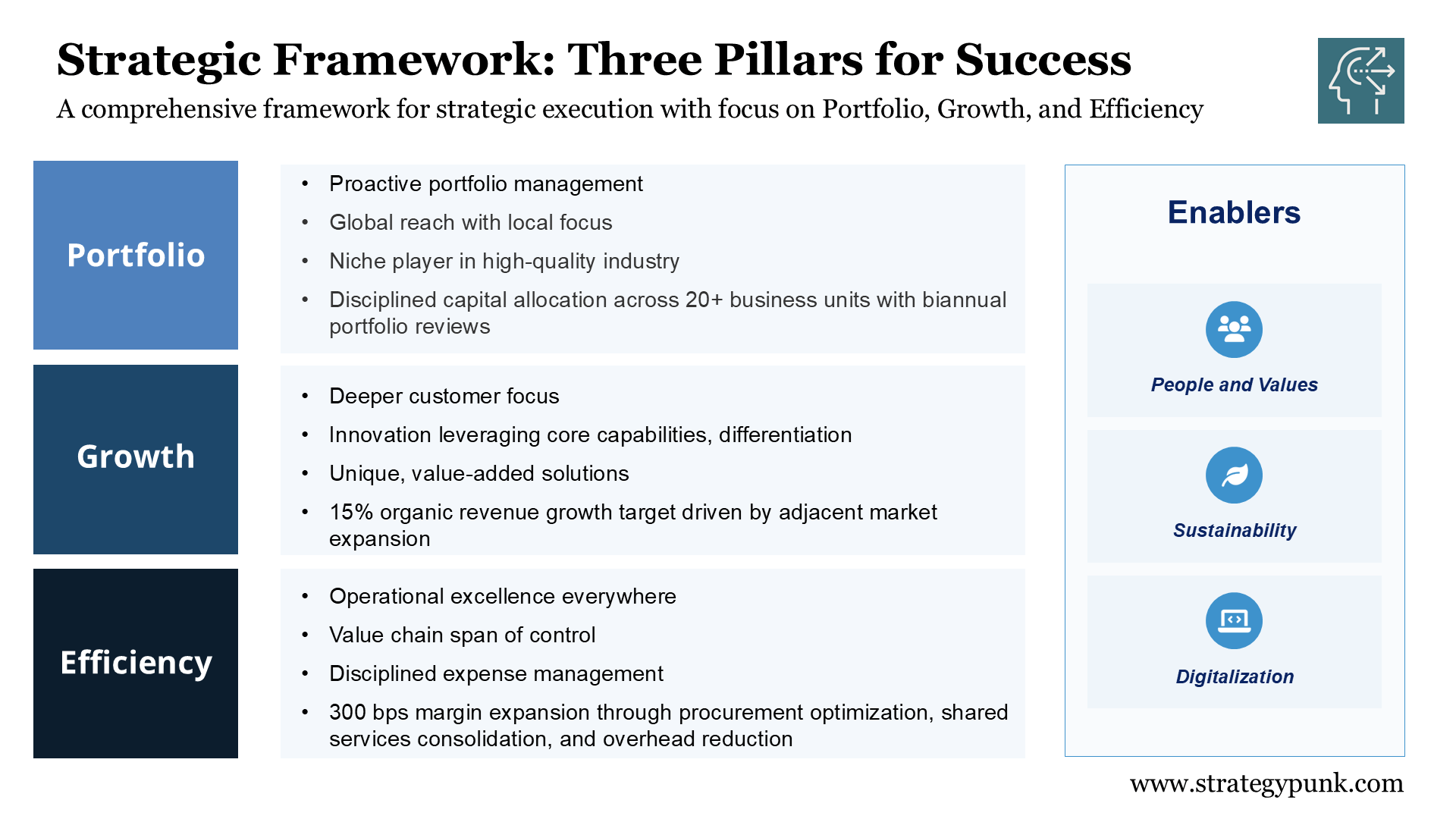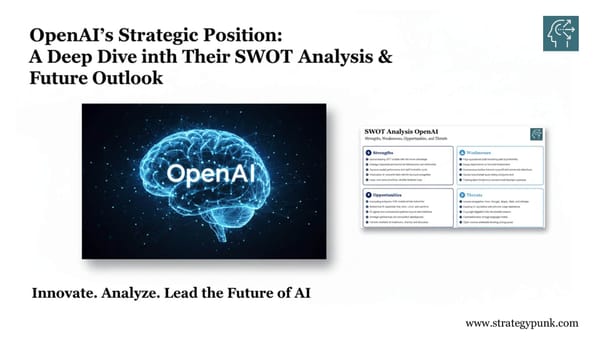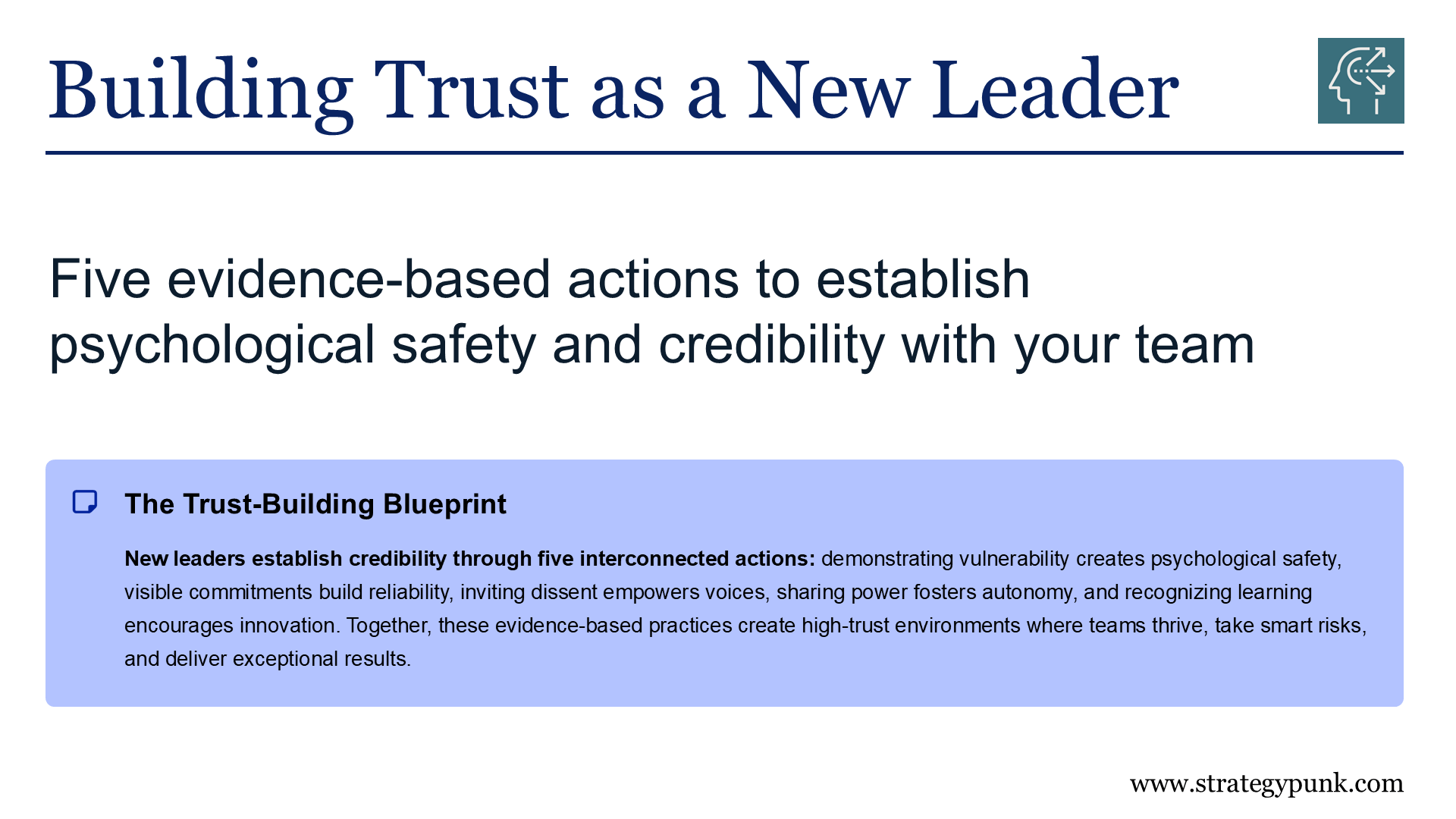OODA Loop Powerpoint template: Mastering Adaptive Decision-Making
Master adaptive decision-making with our OODA Loop guide and free & fully editable PowerPoint template.
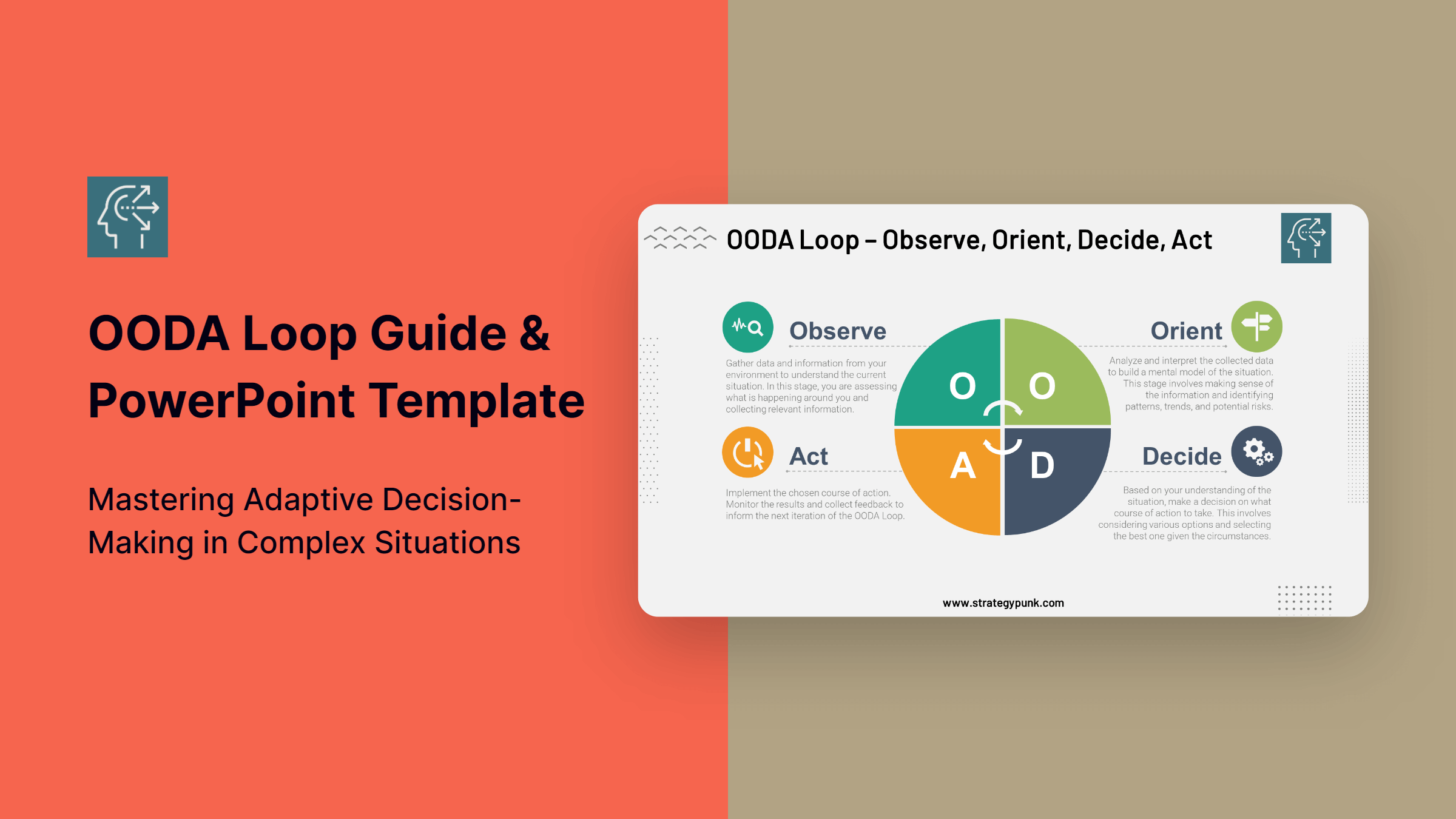
In today's fast-paced world, swift and effective decision-making is vital.
Enter the OODA Loop — a four-step Observe, Orient, Decide, Act framework developed by Colonel John Boyd to navigate complex situations.
By continuously cycling through these stages, individuals and organizations can adapt quickly to changing environments and stay ahead of the competition.
This article explores practical applications of the OODA Loop and offers tools to enhance adaptive decision-making in various contexts.
Origins and Purpose
USAF Colonel John Boyd first developed the OODA Loop strategy in the mid-1950s as a concept of situational awareness and tactical decision-making in military operations. The approach has since been applied to various domains, including business, sports, and emergency response situations. The primary purpose of the OODA Loop is to help individuals and organizations process and analyze available information efficiently and effectively to make quick and accurate decisions in high-pressure, dynamic scenarios.
Fundamental Components: Observe, Orient, Decide, Act
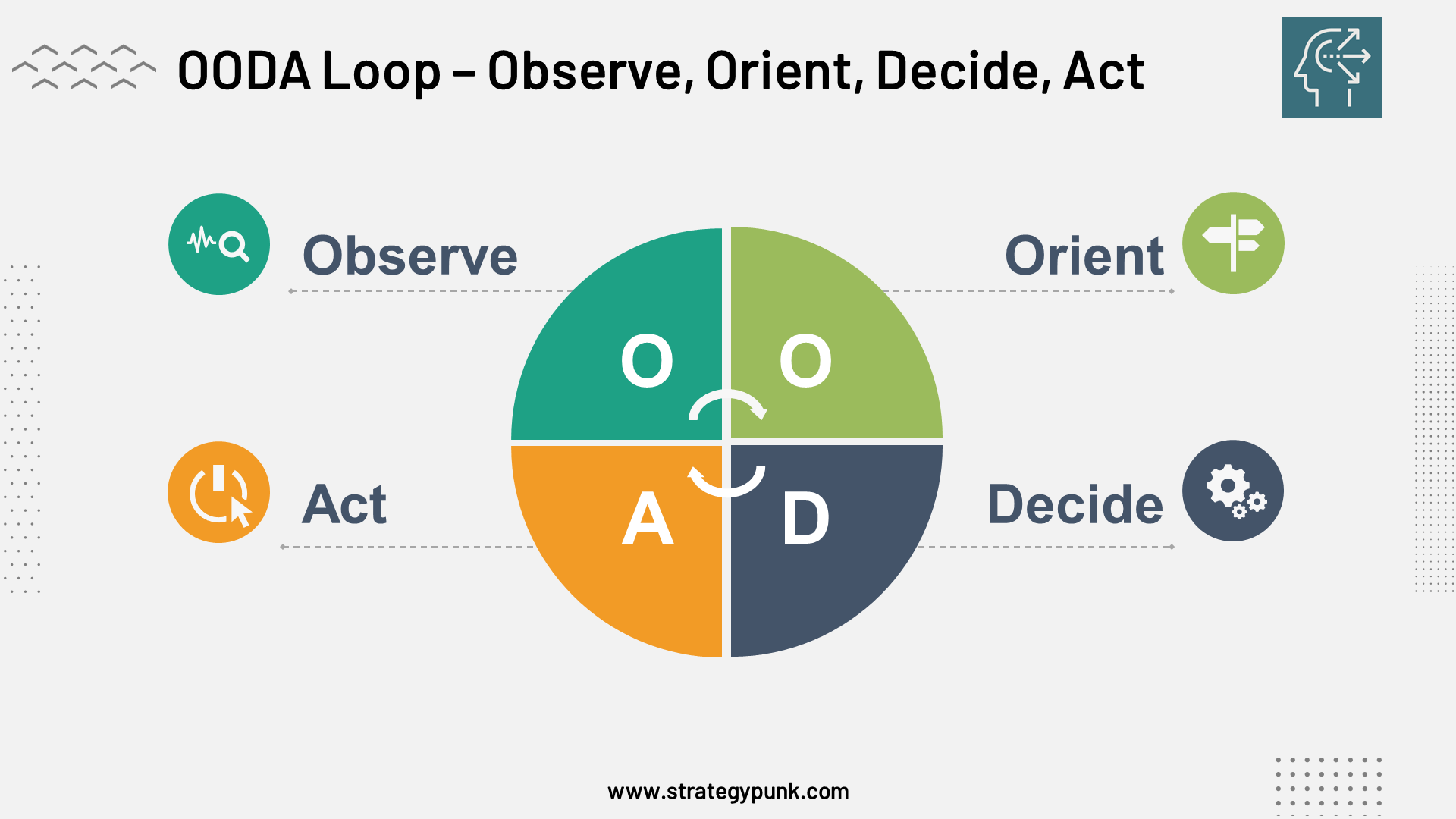
Observe
The first step of the OODA Loop is to gather information about the current environment and context. This involves collecting data from multiple sources, such as direct observation, sensors, or other forms of communication. The goal is to obtain an accurate and comprehensive understanding of the situation.
Orient
In the Orient phase, the information is processed, analyzed, and filtered to make sense of the situation. This involves comparing new data with existing knowledge, assumptions, and experiences. The purpose is to identify the situation's most relevant and critical aspects, based on which further decisions can be made.
Decide
Once an accurate understanding of the situation has been established, the next step is to develop a range of possible actions or responses. This involves weighing each option's potential consequences, risks, and benefits and considering the available resources, time constraints, and external factors. The outcome of the Decide phase is to select the most appropriate course of action.
Act
The final step in the OODA Loop is to execute the chosen course of action. This may involve delegating tasks, coordinating resources, or directly implementing the preferred approach. Once the action has been taken, the process begins again by observing its consequences and reevaluating the situation. This continuous cycle allows for ongoing adaptation and refinement of decision-making in response to changing circumstances.
Strategies for Navigating the OODA Loop
The OODA loop (Observe, Orient, Decide, Act) is a decision-making framework designed to increase agility in dynamic and complex environments. This section will provide methods to enhance each stage of the OODA loop.
Effective Observation Techniques
Observation is the first stage of the OODA loop, which involves collecting data about the environment. Strategies for practical observation include:
- Utilizing diverse sources of information: gather data from various internal and external channels to the organization.
- Continuous monitoring: monitor changes regularly to stay up-to-date with the latest trends and developments.
- Filtering and prioritizing data: focus on relevant and actionable information while filtering out noise and distractions.
- Collaborating with stakeholders: Involve team members, customers, and partners in data collection to understand the situation comprehensively.
Orientation Approaches
The orientation stage encompasses interpreting the observed information and understanding one's position in the environment. Some approaches to enhancing orientation are:
- Establishing a shared mental model: develop a common understanding of the situation and the organization's goals among team members.
- Assessing organizational culture and prior experiences: Analyze how organizational values, biases, and history can shape perception.
- Performing situational analysis: Use analytical frameworks, such as SWOT or PEST, to structure the interpretation of observed data.
Decisive Decision-Making
The decision stage requires choosing the best course of action based on the orientation. Some essential strategies for decisive decision-making are:
- Scenario planning: Compare multiple possible actions and assess their potential outcomes.
- Developing alternative options: Create a range of potential actions to enable adaptability when faced with unexpected changes.
- Implementing a decision-making framework: Use a structured approach to evaluate options, such as the decision tree or cost-benefit analysis.
- Encouraging team involvement: engage team members in decision-making processes to promote ownership and increase the likelihood of success.
Adaptive Action Planning
The final stage, acting, involves executing the chosen action and monitoring the outcomes. Implement the following strategies for adaptive action planning:
- Building feedback loops: establish methods to gather and analyze feedback throughout the execution process.
- Adjusting plans iteratively: incorporate feedback and adjust as needed to respond to changing environments.
- Creating learning opportunities: facilitate ongoing learning and improvement by identifying lessons learned and sharing best practices.
Applying the OODA Loop to Complex Environments
In today's fast-paced and ever-changing world, navigating complexity and making adaptive decisions are crucial. One practical and powerful approach to achieving this is using the OODA Loop.
The OODA Loop, which stands for Observe, Orient, Decide, and Act, is a continuous decision-making cycle designed to help individuals and organizations adapt to dynamic and competitive situations.
Business and Management
In business and management, the OODA Loop is an effective tool for helping leaders make better decisions under pressure and uncertainty. The first step, observing, involves gathering information about the current situation, including internal and external factors affecting the organization. Updating this information is crucial, as the focus should be on real-time data and situational awareness.
Next, the leader must Orient themselves, evaluating the newly acquired data based on their knowledge, experience, cultural background, and other relevant factors. This step helps understand the situation and identify key trends, opportunities, and threats.
After analyzing the situation, the decision-making process starts. Leaders should make decisions quickly but remain flexible enough to adapt to new information or changing circumstances. Finally, leaders need to take action based on their choices, moving the organization toward its goals and learning from previous cycle iterations.
Military and Defense
The OODA Loop has its roots in military strategy and remains a valuable decision-making tool for modern defense organizations. In military operations, where rapid and effective decision-making can be the difference between success and failure, the OODA Loop helps commanders assess and react to evolving situations in r.
Commanders can adapt their plans and tactics to achieve objectives while remaining ahead of the adversary through a continuous cycle of observing the battlefield and orienting oneself through analysis and decision-making. The goal is to move through the OODA Loop faster than the opponent, staying one step ahead and maintaining the initiative.
Emerging Technologies
In emerging technologies such as artificial intelligence, robotics, and cybersecurity, the OODA Loop offers a framework for making informed decisions in rapidly evolving and competitive environments. By following the loop's steps, decision-makers can harness the power of cutting-edge technologies while remaining agile and adaptable to new developments.
For example, in the context of artificial intelligence, decision-makers can first observe the available data and assess the technology's capabilities. While orienting, they can consider AI's potential impact on their industry and the potential threats and opportunities it presents. Finally, they can decide on the appropriate course of action, whether adopting AI solutions, investing in research, or collaborating with other organizations to maximize benefits.
Challenges and Limitations of the OODA Loop
The OODA Loop is an effective decision-making model, but it also faces some challenges and limitations that organizations should consider while employing this approach.
One challenge is the need for accurate and relevant information in the observation phase. Organizations must have access to reliable information about their environment to make effective decisions. However, in complex situations, information may need to be completed, ambiguous, or rapidly changing, making it difficult to assess the environmental source accurately.
Another area for improvement is that it may only sometimes accommodate differences in individual cognitive styles and decision-making preferences. Some prefer a more systematic, analytical approach, while others rely on intuition and improvisation. Consequently, there may be better decision-making models for all situations or all individual sources than the OODA Loop.
The OODA Loop also requires constant iterations to be effective, which can be time-consuming and demanding on organizational resources. The speed at which a team can navigate the OODA Loop is crucial to the organization, especially in fast-paced, dynamic environments. However, continuous iterations may strain the organization.
Lastly, the OODA Loop may need to be more applicable or effective in highly structured, hierarchical organizations. In such environments, decision-making is typically centralized, and rigid protocols may hinder the flexibility and adaptability that the OODA Loop emphasizes for success sources.
Conclusion
In today's rapidly evolving world, navigating the OODA Loop is essential for making adaptive and effective decisions in complex environments. By understanding and applying the observe, orient, decide, and act stages, individuals and organizations can respond swiftly and appropriately to changing circumstances.
One key takeaway is gathering and analyzing accurate information (observation)to determine the individual or organization's goals (orientation). A thorough understanding of internal and external factors impacting the decision-making process is crucial in accurately understanding the environment.
Moreover, it is vital to consider the influence of previous experiences and knowledge on the orientation phase, as recognized by John Boyd's Recognition Primed Decision (RPD) concept. This influences how decision-makers perceive and interpret available information, ultimately shaping their choice of action.
Finally, decision-makers must be prepared to act quickly, efficiently, and resilient, continually adjusting their strategies as new information becomes available. This adaptability allows them to stay ahead of their competitors and to respond effectively to the challenges imposed by complex environments.
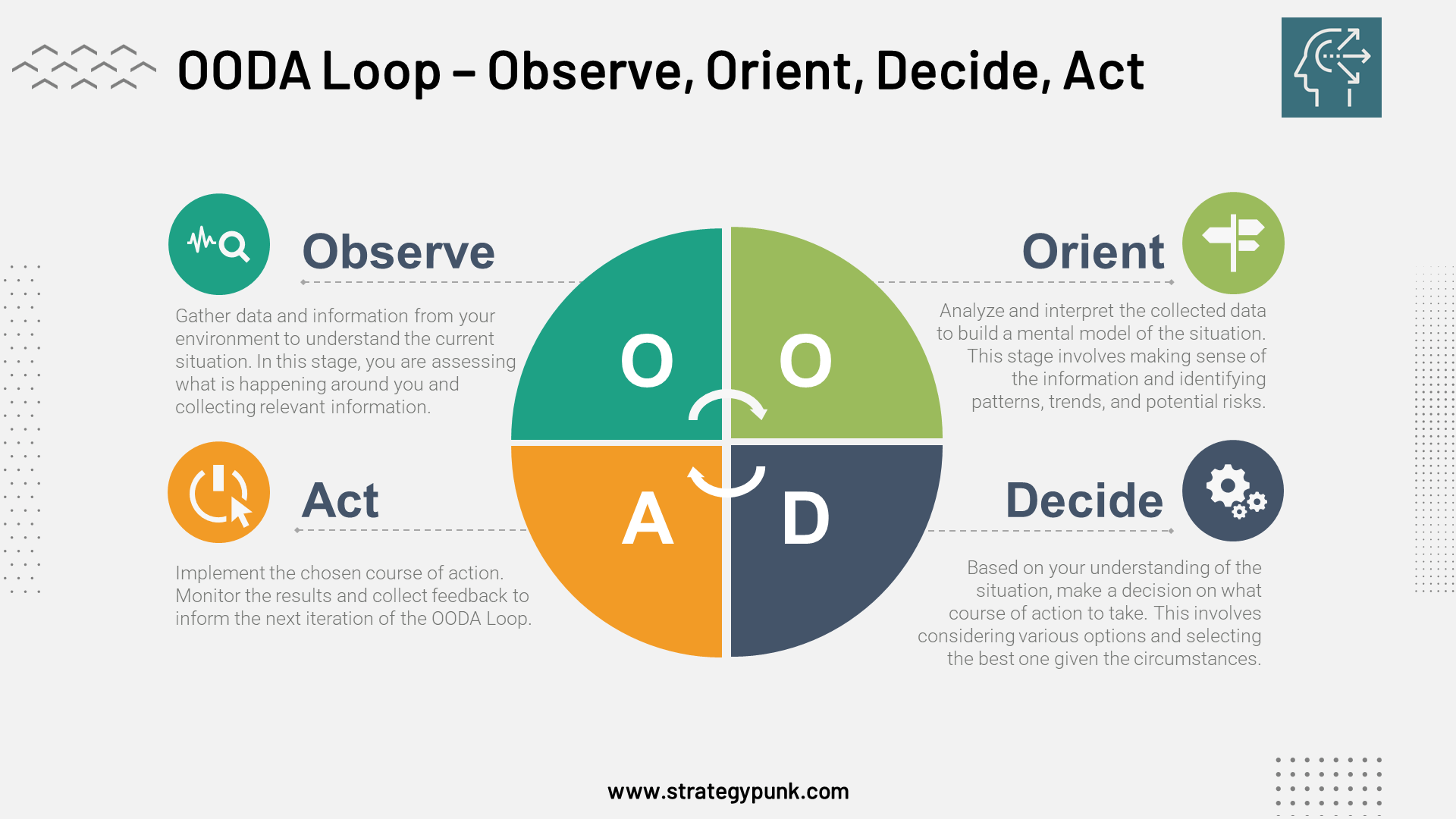
The OODA Loop is a robust framework that can significantly enhance decision-making skills in complex and rapidly evolving situations. Mastering this process will better equip you to navigate life and work challenges, make effective decisions, and adapt to change swiftly.
To help you start your journey to mastering adaptive decision-making, we have created a comprehensive and entirely editable PowerPoint template that will serve as an excellent visual aid. This template is designed to simplify the OODA Loop concept, making it more accessible and easier to grasp.


